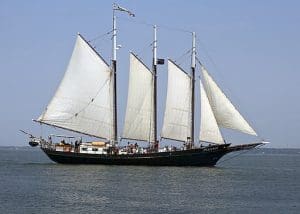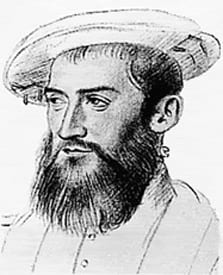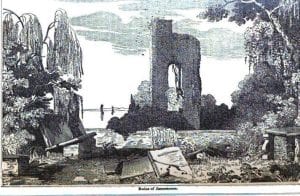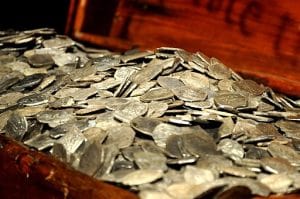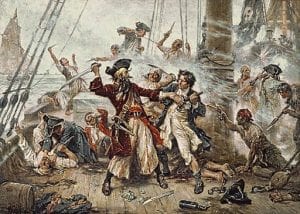Before the United States existed, they roamed the continent's eastern shores, in search of plunder, weapons, and ships. They menaced colonists and merchants alike, taking what they could for as long as the law was weak. Some of them sought to mingle with the colonists, trading with them and even trying to leave behind their dangerous life. Others chose to fight to the bitter end, dying in combat with the navy or sinking to the bottom of the raging sea. These are the pirates of the East Coast, who ranged far away from the Caribbean, from the Outer Banks to the Chesapeake and as far north as Massachusetts. The pirates would play an especially important part in Virginia’s early history. This article serves as a quick recounting of those early, tumultuous days before there was an American nation and when darkness ruled the seas. Read on for the swashbuckling details, and check out these books from our collection:
Days of Privateers and Pirates: Before Jamestown and the British Colonies
Since the early days of colonization of the New World by European powers, there was piracy. Many of the very earliest pirates were not actually outlaws or criminals in the eyes of their nations but privateers. A privateer is an agent of a government who attacks the shipping and fleets of an opposing nation or nations. Privateers during the colonial period carried “letters of marque,” which allowed them to hire crews, buy ships, and engage in what would otherwise be criminal acts legally. As long as they carried the letter of marque with them, their government would not prosecute them for their actions.
The earliest settlement on the East Coast of what would become the United States was a colonial outpost of privateers. In 1562, French naval officer Jean Ribault landed with 28 crewmen on what is now Parris Island, South Carolina. The colony was named “Charlesfort” after the French king, and it was made to serve as a base for French pirates to attack the Spanish ships in the area. After the small fort was constructed, Ribault sailed back to France to get more supplies for the colony. But Ribault could not return to Charlesfort because he quickly became involved in the French Wars of Religion. The situation rapidly turned dire for the colonists, who faced hostile American Indian tribes without the promised supplies. They killed their captain, abandoned the colony, and sailed back to France in less than a year.
The end of the Charlesfort colony was not the last of Ribault’s adventures in the New World. Ribault was chosen once more by the French king, Charles IX, to set up a colony, this time in what is now Jacksonville, Florida. It was a race between the French and Spanish colonial empires to establish settlements and construct military fortifications. As before, Ribault’s crew consisted of Huguenots (French Protestants), who had a deep enmity for the Spanish Catholics. Under the command of Ribault’s former second-in-command, Rene Goulaine de Laudonniere, they established the colony of Fort Caroline in 1564. Ribault himself followed and reached the colony in 1565 to take command.
For roughly a year, Ribault’s force at Fort Caroline persevered, but it began to attract the attention of the Spanish. Pedro Menendez de Aviles raced Ribault’s fleet for Florida and managed to engage him in naval combat but was unable to achieve a decisive victory at sea. Menendez was forced to a smaller harbor south of Fort Caroline, in which he established a fort he named “St. Augustine” in 1565. Ribault moved his fleet southward to attack St. Augustine and eliminate the Spanish presence in the area before it could become deeply rooted. But his ships were destroyed by a powerful hurricane, and many of his men drowned. Menendez took the opportunity to launch an attack on Fort Caroline with 500 men; he took the fort and hanged virtually all the captured French soldiers on trees with the inscription, “Not as Frenchmen but as Lutherans.” Ribault and the survivors of the shipwrecks were then captured and executed by the Spanish. The French would never have another colony in what is now Florida, and St. Augustine would go on to become the oldest continually occupied city on the East Coast of the United States.
Ribault’s suffering and defeat would be avenged by Dominique de Gourges, who set sail for Cuba in 1567 with a crew of 200 men without telling them his true intentions. Once he reached Cuba, he told them his goals, and they approved of his plan of vengeance. He enlisted the aid of a tribe of American Indians, who were also at war with the Spanish, and attacked and captured Fort San Mateo, the renamed Fort Caroline. Before he burned the fort to the ground, he hanged all the captured Spanish troops on trees with the inscription, “Not as Spaniards but as murderers.” Such bloody conflicts marked the days of privateers and colonial wars before the birth of the concept of American religious freedom.
Virginia’s Dawn: The Jamestown Colony and Piracy
The first lasting colony of the British on the East Coast, Jamestown, was established in 1607, decades after the conflict of Fort Caroline and St. Augustine. British colonization of the New World was slower than that of Spain and France, and several attempted colonies failed, most notably the Lost Colony of Roanoke in what is now North Carolina. The site of Jamestown was chosen partly because of its military usefulness; not only was it in a swamp uninhabited by American Indians, but it was also far inland enough to make Spanish attacks by sea difficult. Even though the Jamestown swamp was filled with disease and biting flies, its location proved very useful in the early colonization effort.
The Spanish immediately interpreted Jamestown as a military base and pirate colony. Upon its founding, Zuniga, the Spanish ambassador in London wrote to King Phillip III of Spain, “It appears clearly to me now that it is not their intention to plant colonies, but to send pirates out from there, since they do not take women, but only men.” Unable to persuade King James I of England to abandon the colony, Ambassador Zuniga continued to report on its progress and encouraged Phillip III to order a military action to destroy it. Even as the colony slowly became self-sufficient and began growing its population through "tobacco brides," the Spanish took no action to destroy it.
The Jamestown colony did become associated with a very important act of piracy slightly later in its history. In August 1619, the first enslaved Africans arrived in Jamestown on what John Rolfe called a “Dutch ship.” This was, in fact, the English pirate ship White Lion, which had stolen about 60 enslaved Africans from the Portugese ship San Juan Batista, which was bound for Mexico. Whether Rolfe had falsified the White Lion as a Dutch ship because of the unseemly association with piracy or had been mistaken because the ship was flying a Dutch flag to disguise itself is unknown. This was the first time enslaved Africans had been obtained by an English colony and marked the beginning of slavery in what would become the United States. It is likely that pirates visited Jamestown on many other occasions in search of trade, although most of their cargoes were not as historically significant as the White Lion’s was.
Peuman, the Pirate of Caroline County
In the early days of the American colonies, pirates often came ashore to trade with the colonists–or to steal from them. One suspected thief was the French pirate, Captain Peuman. Peuman’s story is told in a festival that takes place in Caroline County every year. Peuman was a pirate who traveled up and down the Rappahannock River, stealing cattle and other valuables from the townsfolk as he went. After months of raiding and property loss, the colonists became outraged and organized a militia to slay their tormentor. They sighted his ship traveling on the Rappahannock and gave chase, forcing him into a branch of Mill Creek. His ship was trapped there, and the militia engaged and killed him and his crew. The stream became known as Peumansend (Peuman’s End) forever afterwards. Little else is known about Captain Peuman because, like many pirates, he left as little information about his life and true identity as possible. We don’t even know if “Peuman” was his real name or an alias he went by.
Davis, Wafer, and Hinson: Pirates! And Early Funders of William and Mary
Some pirates did manage to enrich the lives of the colonists, even if it was against their will. The pirate trio of Davis, Wafer, and Hinson were such men. Davis’ career as a pirate dated back to around 1679. He was a privateer for Britain and was allowed to raid the Spanish and French colonies during times of war with those nations. His raids took him all across the seas of the New World, from Panama to the coasts of Peru and Chile and finally to the West Indies and Barbados. His raiding career, with his crewmates Wafer and Hinson, ended in 1688, two years after the English king had warned all privateers to seek a pardon and end their attacks within twelve months. After traveling from Philadelphia to Maryland, they were captured in Point Comfort, Virginia. Although the men were held on a charge of piracy, they were not convicted or executed due to a delay in the legal proceedings and were released in 1689. They successfully obtained the king’s pardon after agreeing to donate 300 pounds to “the pious design of a free School and College in Virginia.” That school would become known as the College of William and Mary.
Black Sam Bellamy, The Prince of Pirates
Some pirates had their headquarters even further north than Virginia. The wealthiest pirate yet known, Sam Bellamy operated mainly out of New England, especially Massachusetts. Born in Devon, England, Bellamy immigrated to Cape Cod, Massachusetts, in 1715. Coming from a poor family, he was always in search of wealth and left Cape Cod in 1716 with a group of men to seek gold from the wreckage of the 1715 Spanish treasure fleet. He found little treasure and decided to sign up with pirate captain Benjamin Hornigold to seek his fortune. Hornigold did not stay captain of his ship, the Marianne, for long; he was deposed as captain following a vote in 1716 and left the ship with his remaining loyalists, including his first mate Edward Teach.
As captain of the Marianne, Bellamy raided and captured ships all across the Caribbean. He became known as “Black Sam” because of the dark color of his hair. He would go on to capture ships much larger than the Marianne, including the Whydah, a 100-foot-long galley. Bellamy never forgot that he had seized power by a democratic vote and tried to treat his crew well; many of them came to regard him as “Robin Hood of the Sea.” Two months after acquiring the Whydah in 1717, Bellamy set sail for Massachusetts once more; the exact reason for his return remains unknown. He never reached his destination, for the Whydah was sunk in a powerful nor’easter on April 16, 1717. The galley’s wreck was rediscovered in 1984, and, with the discovery of its bell in 1985, it became the only fully authenticated shipwreck from the Golden Age of Piracy. Numerous silver coins have been found in the ship’s remains, a fitting legacy for the richest pirate in American waters.
Blackbeard, the Face of Horror
But what of Hornigold’s loyal first mate, Edward Teach? He would eventually lose faith in his captain as well, growing restless and irritated as Hornigold forbade attacks on British treasure ships. At some point in 1717, Hornigold was voted out as captain and left his ship, the Revenge, with Teach. The earliest mention of a pirate named “Blackbeard” dates to the summer of 1717, suggesting that Teach had become the pirate captain by that point. As a captain, Teach used the power of a formidable appearance to guarantee the obedience of his crew and the submission of his enemies. A tall and thin man, Blackbeard had a long and elaborate beard, designed to look as frightening and barbaric as possible; he put fuses into his beard and lit them so that he “looked like the devil” to his enemies. The cloud of smoke coming from the fuses encircled his head and made it look like hellfire was coming from his face.
With the power of the Blackbeard persona, Teach plundered his way across the Caribbean. He seized the French merchant vessel La Concorde on November 28, 1717, and renamed it Queen Anne’s Revenge. The Queen Anne’s Revenge was equipped with 40 cannons and had tremendous firepower compared to many of its targets. After seizing several ships and gaining many crew members, Blackbeard shifted course and began to travel north along the East Coast. Teach and his fleet reached Charles Towne (Charleston), South Carolina, by May 1718. His fleet blocked all trade by sea from Charles Towne, and he demanded medicine rather than gold, for many of his crewmen had acquired horrible diseases. His threat to kill all the prisoners he had acquired during the blockade was not taken lightly; stories of Blackbeard’s terrifying appearance and many unwilling wives served to terrify the townsfolk. Teach received the medicine he requested, and in return, let the prisoners go free before he sailed out.
After such a brazen raid, Blackbeard traveled further north to the place of his eventual demise. In Charles Towne, he learned former pirate Woodes Rogers had been appointed to bring law to the pirate colony of New Providence. Fearing his old territory was now too dangerous, he sailed for North Carolina. While off Topsail Inlet, several of his ships were sunk, including the Queen Anne’s Revenge. With his fleet reduced, Blackbeard finally decided to seek the King’s Pardon and leave his life of piracy. He thought that Governor Eden of North Carolina was a man he could trust to pardon him and took steps to maximize his share of the loot he would take with him into his new life. Teach went so far as to maroon as much of his crew as he could prior to his pardon, to make sure he would be able to keep most of the spoils!
Alexander Spotswood and Blackbeard’s End
Blackbeard settled in Ocracoke, North Carolina, after his pardon. The pirate had become so infamous that he attracted the attention of Governor Spotswood of Virginia, who feared that Governor Eden could not control the pirates and that they would travel further north to launch attacks in Virginia waters. Spotswood learned of Blackbeard’s location from his former quartermaster, William Howard. Spotswood sent a two-pronged attack after Blackbeard, deploying a force to travel overland to Bath, North Carolina, and two armed sloops commanded by Robert Maynard to attack by sea. It was the sloops that found Blackbeard and engaged him in a spectacularly bloody battle; roughly a third of Maynard’s forces alone died in the opening fire from Blackbeard’s ship. The ships circled, firing at each other for hours. Eventually Blackbeard launched a boarding party, but Maynard had anticipated this and kept his remaining men below deck for a counterattack. In ferocious melee combat, they stabbed and shot furiously at Blackbeard’s pirates. Blackbeard himself fought savagely but finally fell; he was said to have been shot five times and cut twenty before he finally died. Maynard brought the head of Blackbeard back on his ship’s bowsprit to Virginia, and the head was displayed by Spotswood for several years in the harbor of Hampton Roads, at a place now called Blackbeard’s Point. Thus, the Golden Age of Piracy ended.

